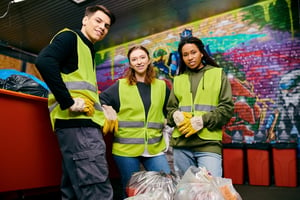Cleanup events are important, but data is what turns those efforts into long-term solutions. By...
Beyond Plastic: Other Types of Litter You Should Know About
When we think of litter, plastic often comes to mind first. Its detrimental effect on ecosystems is well-documented, but plastic is just the tip of the iceberg. Litter pick-up initiatives often deal with a variety of waste materials, each contributing to environmental pollution in unique ways. Understanding the different types of litter can help us be more mindful of our consumption and disposal habits. Below, we explore the most common types of litter beyond plastic, and why they need our attention too.

Cigarette Butts Are More Than Little Filters
Cigarette butts are one of the most littered items globally. Despite their small size, they have a large environmental impact. Made of cellulose acetate, a type of plastic, cigarette filters can take up to 10 years to decompose. Additionally, cigarette butts contain toxins that can leach into the soil and water, poisoning marine and terrestrial life. During litter pick-ups, cigarette butts are often found in parks, beaches, and streets, highlighting the need for better disposal practices.
Glass Is More Than a Broken Window
Glass is a recyclable material, yet it often ends up as litter, particularly in public spaces like parks and beaches. Glass can take up to a million years to break down, posing risks to wildlife and humans alike. Broken glass can cause injuries and, in natural settings, it can start wildfires by magnifying sunlight. Picking up glass litter is essential not just for aesthetics, but also for safety and environmental preservation.
Metal Is More Than the Last Shiny Thing
Aluminum cans and metal scraps are commonly found in litter pick-ups, especially near recreational areas. While metals like aluminum and steel are highly recyclable, they often end up in landfills or as litter. These materials can take hundreds of years to degrade, and when left in the environment, they can leak harmful chemicals into the soil and water.
Paper Is More Than Yesterday’s News
Paper might seem like a harmless type of litter, as it is biodegradable. However, in large quantities, discarded paper can clog waterways and lead to unsightly litter piles in urban environments. Moreover, when exposed to rain, paper litter can carry dyes, chemicals, and inks into the soil, potentially contaminating water sources. Paper recycling and proper disposal remain essential to minimize these impacts.
Wood Is More Than a Broken Antique
Wood litter, whether from construction projects or discarded furniture, is often treated with chemicals that can be harmful when left in the environment. Pressure-treated wood, for instance, contains toxins that can leach into soil and groundwater. While natural wood decomposes over time, treated wood can take much longer to break down, posing risks to local ecosystems.
Rubber Is More Than a Party Balloon
Rubber litter, such as old tires or discarded rubber products, is a significant issue in both urban and rural environments. Rubber does not break down easily and can persist in landfills or as litter for decades. Additionally, it can release harmful chemicals into the environment, particularly when burned. During litter pick-up efforts, discarded rubber products often require specialized disposal methods to mitigate their environmental impact.
Fabric Is More Than an Old Fashion Fad
Old clothing and fabrics are frequently found during litter pick-ups, especially in more remote areas or near landfills. While natural fabrics like cotton and wool can biodegrade, synthetic fibers such as polyester take much longer to break down and can release microplastics into the environment. Textile waste is a growing issue, exacerbated by fast fashion, and proper disposal or recycling is crucial to reducing its impact.
Vehicle Parts Are More Than an Accident
Discarded vehicle parts, such as bumpers, batteries, or even entire car frames, can be found in abandoned areas or along rural roads. These items are not just an eyesore; they can leak harmful substances like oil, antifreeze, and heavy metals into the environment. Litter pick-up initiatives in rural and remote areas often face the challenge of removing these bulky, hazardous items.
Organic Matter Is More Than Lunch Leftovers
Organic litter, including food scraps and yard waste, may seem harmless, but when left to decompose in large quantities, it can create methane—a potent greenhouse gas. Additionally, decomposing organic matter can attract pests, disrupt local ecosystems, and pollute water sources. Proper composting and organic waste management are key to reducing the impact of organic litter.
Foam Is More Than Was Necessary
Styrofoam is a notorious pollutant, often found in waterways, parks, and beaches. It takes hundreds of years to break down, and during this time, it can fragment into smaller pieces that are ingested by wildlife, causing internal blockages or poisoning. Foam is particularly challenging to clean up during litter pick-up events, as its lightweight nature allows it to spread easily across large areas.
Electrical Parts Are More Than Old Batteries
Electrical waste, or e-waste, is a growing type of litter, especially as electronic devices become more disposable. Discarded phones, batteries, chargers, and other electronics can leak toxic materials like lead, mercury, and cadmium into the environment. E-waste requires specialized recycling processes to prevent environmental contamination and human health risks.
Conclusion
Litter pick-up efforts address much more than just plastic pollution. From cigarette butts and glass to rubber, fabric, and even vehicle parts, various types of waste contribute to environmental degradation. By understanding the diversity of litter and its impacts, we can become more proactive in reducing waste and encouraging others to properly dispose of or recycle their trash. The next time you see litter on the ground, remember: it’s not just an eyesore—it’s a hazard to our planet.
Want to help make an impact on your community? We are launching a brand new phone application to easily record, track, and analyze litter pick up events. Sign up for our newsletter to hear when our new “XLitter” app goes live! Want to be a Beta Tester? Contact us for more information.




